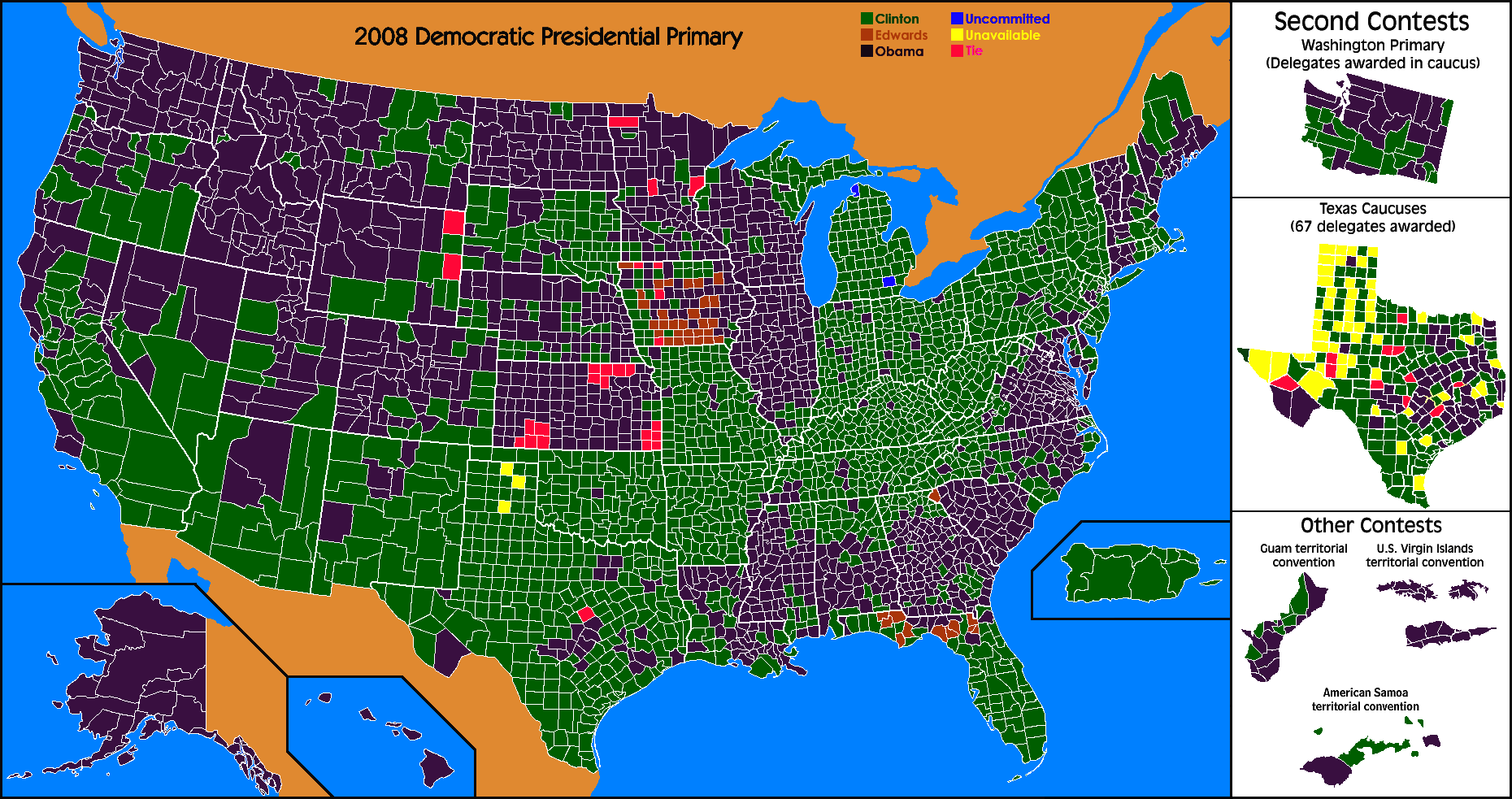Obama versus Clinton, county by county
Herewith an intriguing county-by-county look at the 2008 Democratic presidential primary:

Barack Obama's counties are in purple; Hillary Clinton's, in green.
The comparison with the county-by-county results of the 2004 presidential election is also interesting:

The 2004 map follows the color coding that has become familiar since the 2000 presidential election: Democratic counties (Kerry) in blue, Republican counties (Bush) in red.
The similarities between these maps jump out almost immediately, even to the casual eye.
Barack Obama's strength, by and large, lay in the counties that John Kerry carried in 2004, while Hillary Clinton tended to carry counties that favored George W. Bush. There are exceptions, especially (1) in states where delegates were awarded on the basis of caucuses rather than primaries, a process that heavily favored Obama; and (2) in states voting immediately after Super Tuesday, which contests Clinton notoriously failed to anticipate. States that fit both these categories skewed heavily in favor of Obama; this effect is especially pronounced in the interior West and Alaska.
But the overall trend is pronounced. What does it say about the general election? Will Obama's stronger appeal within Democratic strongholds translate into greater enthusiasm and turnout in those areas? Or would the Democratic Party have been better served by nominating Hillary Clinton, whose claim to superior strength in battleground states is buttressed by these maps?
Ah, such a fine parlor game, which might have translated into real results for Hillary Clinton had the Senator and her staff learned what the Obama campaign team evidently understood:

Barack Obama's counties are in purple; Hillary Clinton's, in green.
The comparison with the county-by-county results of the 2004 presidential election is also interesting:

The 2004 map follows the color coding that has become familiar since the 2000 presidential election: Democratic counties (Kerry) in blue, Republican counties (Bush) in red.
The similarities between these maps jump out almost immediately, even to the casual eye.
Barack Obama's strength, by and large, lay in the counties that John Kerry carried in 2004, while Hillary Clinton tended to carry counties that favored George W. Bush. There are exceptions, especially (1) in states where delegates were awarded on the basis of caucuses rather than primaries, a process that heavily favored Obama; and (2) in states voting immediately after Super Tuesday, which contests Clinton notoriously failed to anticipate. States that fit both these categories skewed heavily in favor of Obama; this effect is especially pronounced in the interior West and Alaska.
But the overall trend is pronounced. What does it say about the general election? Will Obama's stronger appeal within Democratic strongholds translate into greater enthusiasm and turnout in those areas? Or would the Democratic Party have been better served by nominating Hillary Clinton, whose claim to superior strength in battleground states is buttressed by these maps?
Ah, such a fine parlor game, which might have translated into real results for Hillary Clinton had the Senator and her staff learned what the Obama campaign team evidently understood:
- Delegates, not popular votes or "battlegrounds," decide the nomination.
- In a party that awards delegates by proportional representation rather than winner-take-all, it makes sense to contest primaries and especially caucuses in seemingly remote, delegate-poor states.
- A nomination season that is (a) based on proportional representation and (b) being contested by two closely matched candidates is almost guaranteed to last beyond Super Tuesday.
- Given the relatively low cap imposed by federal campaign finance rules, it is easier to raise money from a larger pool of small donors than from a smaller pool of wealthy donors.
- It's even easier to raise money from the masses when you have a cool website and campaign staffers who know about ringtones, media player skins, social networking sites, and viral videos.










0 Comments:
Post a Comment
<< Home